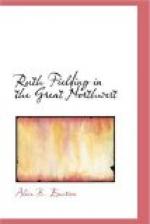Mr. Hammond was not annoyed by it. His mind was fixed upon the scenes that could be filmed in the canyon. Like Jim Hooley, the director, his thought was almost altogether taken up with the making of Ruth’s “Brighteyes.”
The work of making the picture was almost concluded. Wonota, the Indian maid, had lost none of her interest in the tasks set her; but she expressed herself to Ruth as being glad that there was little more to do.
“I do not like some things I have to do,” she confessed. “It is so hard to look, as Mr. Hooley tells me to, at that hero of yours, Miss Fielding, as though I admired him.”
“Mr. Grand? You do not like him?”
“I could never love him,” said the Indian girl with confidence. “He is too silly. Even when we are about to engage in one of the most thrilling scenes, he looks first in the handglass to see if his hair is parted right.”
Ruth could not fail to be amused. But she said cautiously:
“But think how he would look to the audience if his hair was tousled when it was supposed to be well brushed.”
“Ah, it is not a manly task,” said Wonota, with disgust. “And the Indian man who is the villain—Tut! He is only half Indian. And he tries to look both as though he admired me and hated the white man. It makes his eyes go this way!” and Wonota crossed her eyes until Ruth had to cry out.
“Don’t!” she begged, “Suppose you suffered that deformity?”
“But he doesn’t—that Jack Onehorse. Your Brighteyes, I am sure, would have felt no pity for such an Indian.”
“You don’t have to feel pity for him,” laughed Ruth. “You know, you shoot him in the end, Wonota.”
“Most certainly,” agreed Wonota, closing her lips firmly. “He deserves shooting.”
The calm way in which the Indian girl spoke of this taking off of the Indian lover who became the villain in the end of the moving picture, rather shocked the young author.
“But,” said Jennie, “Wonota it only a single generation removed from arrant savagery. She calls a spade a spade. You shouldn’t blame her. It is civilization—which is after all a sort of make-believe—that causes us white folk to refer to a spade as an agricultural implement.”
But Ruth would not laugh. She had become so much interested in Wonota by this time that she wished her to improve her opportunities and learn the ways—the better ways, at least—of white people.
Mr. Hammond naturally looked at the commercial end of Wonota’s improvement. Nor did Ruth overlook the chance the Osage maid had of becoming a money-earning star in the moving picture firmament. But she desired to help the girl to something better than mere money.
Wonota responded to a marked degree to Ruth’s efforts. She was naturally refined. The Indian is not by nature coarse and crude. He is merely different from the whites. Wonota seemed to select for herself, when she had the opportunity, the better things obtainable—the better customs of the whites rather than the ruder ones.




